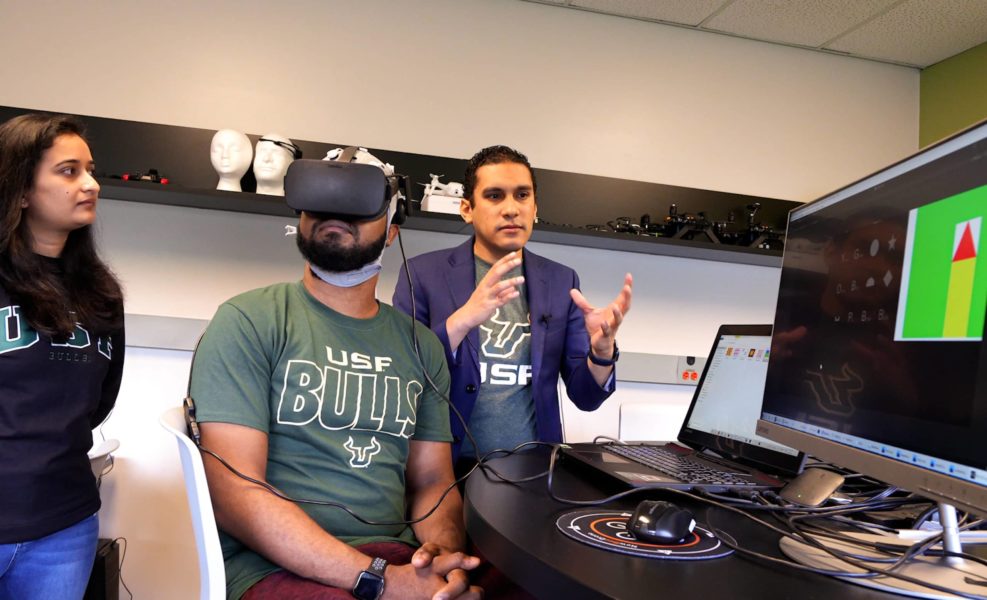USF researcher harnesses brain power to create art

A University of South Florida computer scientist has seemingly brought science-fiction to life, developing a technology that allows people to create abstract images by intensely concentrating on colors and shapes.
Following his previous work with brain-controlled drones, Dr. Marvin Andujar, director of the Neuro-Machine Interaction Lab at USF, is now combining the power of concentration and art. Andujar told the Catalyst that the primary function of his new brain-computer interface (BCI) prototype is to help people with attention-deficit/hyperactivity disorder (ADHD) improve their ability to focus over time.
Andujar said he realized a need for the technology when leading demonstrations of his brain-controlled drones, primarily meant to showcase the innovative potential of BCIs. Pilots imagine they are pushing an object forward, and a headband with wearable electroencephalography systems (EEG) captures their brain signal. The device sends the information to the drone, which is programmed to move when it receives the data.
“At different conferences, adults with ADHD will approach me and ask me, ‘hey, how can I get this technology at home?” said Andujar. “Because it requires a lot of attention to be able to do this kind of task.
“I always say, ‘well, you can’t really buy this technology just yet – this is work we have been pursuing in my research lab.'”
Similarly, Andujar said that college students – some diagnosed with ADHD and some who have difficulty concentrating – would express the need for something besides prescription medicine to improve their focus.
“The community themselves have been telling me they need technologies like this to exist for them,” he added.

Andujar is now looking into curating a VR art exhibit and minting the images into the first brain-based non-fungible tokens (NFTs).
So, Andujar went to work creating a new BCI, allowing those with ADHD to utilize brain painting as a tool to train their attention. Users also receive the mood-lifting capabilities of art, and Andujar even created a virtual reality (VR) version. He is now looking into curating a VR art exhibit and minting the images into the first brain-based non-fungible tokens (NFTs).
While the research team is still analyzing data and Andujar said more long-term tests are needed, participants in a recently completed two-year pilot study funded by the National Science Foundation have shown improvement. Andujar observed improvement in participants using the technology for two or three days a week over a month.
The ultimate goal, said Andujar, is to decrease the reliance on Adderall. The medication, known for its abuse potential – especially among college students – and disturbing eating and sleeping patterns, is the most common treatment for ADHD.
“Right now, we’re not trying to replace medications,” Andujar said. “We’re trying to use this tool more as a supplement -indicating that if you spent 30 minutes doing this every single day, you may not need to take as much medication in the future.”
Users, or artists, sit at a computer wearing an EEG “hat.” When they concentrate on an object or color, the BCI’s machine learning capabilities translate the brain signals into a specific action. In this case, the innovative technologies produce the “art” onto a blank computer “canvas.”
“It requires a large amount of concentration per object to be able to develop these types of abstract paintings,” stressed Andujar.
Andujar noted that art improves emotional states, helping people to relax, and increasing positive moods. He said utilizing the Oculus VR headset while using the BCI allows people to immerse themselves in their paintings, creating an almost meditative state. It also allows them to ignore their cell phones, which Andujar blames for reducing focus in those not diagnosed with ADHD.
Not one to rest on his technological laurels, Andujar hopes to expand the virtual canvas to a metaverse-like experience. He envisions users sitting or standing inside their artwork, with various colors and objects appearing as they turn their heads.
The technology, said Andujar, allows people without a painting background to create art. He added that it could even help create a new community of artists.
Andujar is now actively seeking partners, both in Tampa in St. Petersburg, to help artists showcase their brain paintings. He also plans for live demonstrations on stage to help the audience understand how the process works.
“That’s one of the goals to hopefully host something like that and also make the paintings like an NFT,” said Andujar. “So, each painter will have their own copyright on their paintings.”
“If you look for NFTs of brain-created painting, it has never been done before.”
Andujar said he would work on the NFT component this summer and plans to offer the technology to the general public beyond the scope of his ADHD studies. He hopes to collaborate with and receive guidance input from the local art community, as his expertise encompasses significantly different fields.
“At the end of the day, I’m a scientist,” said Andujar. “I’m an engineer, a computer scientist.
“So, I would definitely like to get the feedback from the art community, for sure.”







